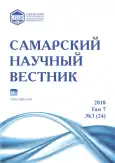Invasive species of Asteraceae family in Kursk flora
- Authors: Nagornaya O.V.1
-
Affiliations:
- Kursk State Agricultural I.I. Ivanov Academy
- Issue: Vol 7, No 3 (2018)
- Pages: 78-82
- Section: 03.02.00 – General Biology
- URL: https://journals.rcsi.science/2309-4370/article/view/21691
- DOI: https://doi.org/10.17816/snv201873114
- ID: 21691
Cite item
Full Text
Abstract
The paper deals with biological features and quantitative characteristics of populations of some invasive species of the family Asteraceae in Kursk flora and their distribution. Kursk, being the industrial and administrative center of the Kursk Region, is characterized by a strong degree of flora transformation, as a result of the active transformation of the territory in recent years, which determines the suitable conditions for the introduction of invasive species and their wide distribution. In Kursk flora there are 43 invasive species, the proportion of Asteraceae is 21%. The paper presents biological features and characteristics of Xanthium albinum and Cyclachaena xanthiifolia populations. The following population indicators were studied: number of individuals, height and total projective cover. It was revealed that the populations of Xanthium albinum in different growing conditions show significant differences in the studied parameters. In the populations of Cyclachaena xanthiifolia fluctuations were observed in the number of individuals per 1 m². The reasons that determine the parameters of populations of invasive species is the degree of disturbance and shading. The study of urban vegetation is a necessary step in the development of measures to optimize the urban environment. The obtained materials will allow to evaluate the consequences of the introduction of these invasive species in the plant communities of Kursk and will provide a scientific basis for monitoring in order to prevent biological invasions.
Keywords
Full Text
##article.viewOnOriginalSite##About the authors
Olga Vyacheslavovna Nagornaya
Kursk State Agricultural I.I. Ivanov Academy
Author for correspondence.
Email: nagornayaov@yandex.ru
candidate of biological sciences, associate professor of Ecology, Horticulture and Plant Protection Department
Russian Federation, KurskReferences
- Виноградова Ю.К., Майоров С.Р., Хорун Л.В. Черная книга флоры Средней России (Чужеродные виды растений в экосистемах Средней России). М.: ГЕОС, 2009. 494 с.
- Гельтман Д.В. О понятии «инвазионный вид» в применении к сосудистым растениям // Ботанический журнал. 2006. Т. 91, № 8. С. 1222-1232.
- Майоров С.Р., Бочкин В.Д., Насимович Ю.А., Щербаков А.В. Адвентивная флора Москвы и Московской области. М.: Товарищество научных изданий КМК, 2012. 412 с.
- Майоров С.Р., Виноградова Ю.К., Бочкин В.Д. Иллюстрированный каталог растений, дичающих в ботанических садах Москвы. М.: Фитон ХХI, 2013. 160 с.
- Vinogradova J. Control of Invasive Alien Species Expansion - as a new Goal for the Botanic Garden // Gardens in our Hearts / ed. by Iu. Naumtsev. Tver: Publ. House of the «Polypress», 2013. P. 207-214.
- Абрамова Л.М. Чужеродные виды растений на Южном Урале // Сорные растения в изменяющемся мире: актуальные вопросы изучения разнообразия, происхождения, эволюции: мат-лы I междунар. науч. конф. СПб.: ВНИИР им. Вавилова, 2011. С. 5-10.
- Пикалова Е.В. Банк семян Ambrosia trifida L. в почвах Оренбуржья // Вестник Оренбургского государственного педагогического университета. Электронный научный журнал. 2014. № 4 (12). С. 86-89.
- Ануфриев O.H. Инвазивные виды семейства Asteraceae Dumort. в Башкирском Предуралье: распространение, биология и контроль численности: дис. … канд. биол. наук. Стерлитамак, 2008. 143 с.
- Майоров С.Р., Виноградова Ю.К. Натурализация растений в ботанических садах г. Москвы // Вестник Удмуртского университета. Сер. «Биология. Науки о Земле». 2013. № 2. С. 12-16.
- Sala O.E., Chapin F.S. [et al.]. Global biodiversity scenarios for the year 2100 // Science. 2000. Vol. 287, № 5459. P. 1770-1774. doi: 10.1126/science.287.5459.1770.
- Исаченко Т.И., Лавренко Е.М. Ботанико-географическое районирование // Растительность европейской части СССР. Л., 1980. С. 10-20.
- Sheppard A.W., Shaw R.H., Sforza R. Top 20 environmental weeds for classical biological control in Europe: a review of opportunities, regulations and other barriers to adoption // Weed Research. 2006. Vol. 46 (1). P. 93-117. doi: 10.1111/j.1365-3180.2006.00497.x.
- Полуянов А.В. Флора Курской области. Курск: Курский гос. ун-т, 2005. 264 с.
- Григорьевская А.Я., Стародубцева Е.А., Хлызова Н.Ю., Агафонов В.А. Адвентивная флора Воронежской области: исторический, биогеографический, экологический аспекты. Воронеж, 2004. 320 с.
- Полуянов А.В., Аверинова Е.А. Травяная растительность Курской области (синтаксономия и вопросы охраны). Курск: Курский гос. ун-т, 2012. 276 с.
- Love D., Dansereau P. Biosystematic studies on Xanthium: taxonomic appraisal and ecological status // Can. J. Bot. 1959. Vol. 37. P. 173-208.
- Бубнель Э.Р., Абрамова Л.М. Семенная продуктивность инвазионных видов Xanthium albinum и Bidens frondosa в Башкирском Предуралье // Вестник Оренбургского государственного педагогического университета. Электронный научный журнал. 2017. № 3 (23). С. 1-6.
- Ломоносова М.Н., Зыкова Е.Ю. Флористические находки в городе Новосибирске // Turczaninowia. 2003. Т. 6, № 1. С. 63-66.
- Левицкий С.С. Список сосудистых растений Центрально-Черноземного государственного заповедника // Тр. Центр.-Чернозем. гос. заповедника им. проф. В.В. Алехина. 1957. Вып. 4. С. 110-178.
- Нагорная О.В. Количественные характеристики Мелколепестника канадского Conyza сanadensis на территории города Курска // Приднепровский научный вестник. 2017. Т. 5, № 3. С. 42-46.
Supplementary files








